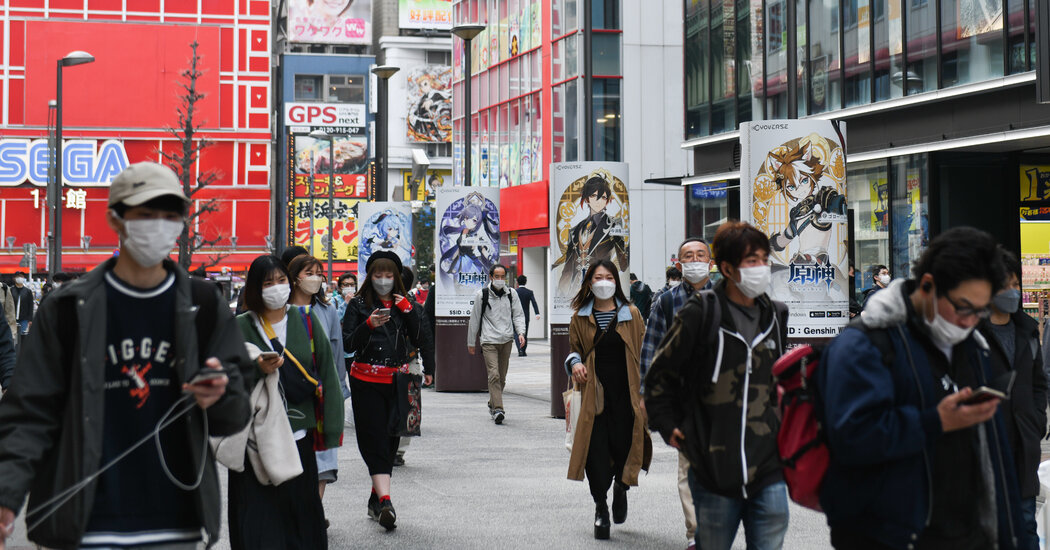
TOKYO — Last December, after two years of stop-and-go growth, Japan’s economic engine seemed like it might finally be revving up. Covid cases were practically nonexistent. Consumers were back on the town, shopping, eating out, traveling. The year 2021 ended on a high note, with the country’s economy expanding on an annual basis for the first time in three years.
But the Omicron variant of the coronavirus, geopolitical turmoil and supply chain snarls have once again set back Japan’s fragile economic recovery. In the first three months of the year, the country’s economy, the world’s third largest after the United States and China, shrank at an annualized rate of 1 percent, government data showed on Wednesday.
A combination of factors contributed to the decline in growth. In January, Japan had put into place new emergency measures as coronavirus case numbers, driven up by Omicron, moved toward the highest levels of the pandemic. In February, Russia invaded Ukraine, spiking energy prices. And that was before China, Japan’s largest export market and a key supplier of parts and labor to its manufacturers, imposed new lockdowns in Shanghai, throwing supply chains into chaos.
The contraction has not been as “extreme” as previous economic setbacks thanks to high levels of vaccine uptake and less wide-ranging emergency measures than during previous waves of the coronavirus, according to Shinichiro Kobayashi, principal economist at the Mitsubishi UFJ Research Institute.
But Japan’s economic recovery from the enormous damage done by the pandemic has also not been as fast as the United States, China or the European Union, he said.
Understand the Supply Chain Crisis
“The pace has been slow,” he said, adding that Japan was the “only country among major economies that hasn’t recovered.”
Growth is likely to bounce back strongly in the second quarter, analysts said, a pattern that has defined Japan’s economy during the pandemic: Demand has waxed as Covid cases have waned, and vice versa.
Still, growth in the coming months will face some tough challenges. The pandemic and the war in Ukraine have fueled big increases in the costs of food and energy in Japan. And moves by the U.S. Federal Reserve to tackle high inflation have caused the value of the Japanese currency, the yen, to plummet. That has driven up costs in the resource-poor country, which is highly dependent on imports for food, fuel and raw materials.
Inflation in the country, while still modest, is rising at its fastest pace in years, with consumer prices in Tokyo increasing by 2.5 percent in April. And over the last year, prices for producers have shot up 10 percent, the highest levels since 1980.
China’s draconian efforts to keep Covid under control are likely to create additional disruptions for Japanese companies that manufacture, source parts and export their goods there.
How the Supply Chain Crisis Unfolded
The pandemic sparked the problem. The highly intricate and interconnected global supply chain is in upheaval. Much of the crisis can be traced to the outbreak of Covid-19, which triggered an economic slowdown, mass layoffs and a halt to production. Here’s what happened next:
Consumer spending “will recover from the downward pressure, but because there are these negative factors, the question is how broad will that recovery be?” said Yoshiki Shinke, a senior economist at Dai-ichi Life Research Institute.
Japan’s prime minister, Fumio Kishida, has tried to offset the effects of price increases with large government subsidies for fuel and cash handouts for families with children. But Japanese consumers, wary of the pandemic’s economic effects, have largely been putting rounds of stimulus money into savings.
Japan’s growth is facing diverse challenges, but ultimately its recovery will depend on Covid, analysts said, a common refrain over the last two years.
While Japan has high vaccination rates and has performed better than most other wealthy countries at keeping the pandemic in check, the virus’s protean nature has made it difficult to predict its path. And that has made experts hesitant to commit to any forecasts about its future impact on global economies.
“The big risk is that corona starts to spread again,” said Naoyuki Shiraishi, an economist at the Japan Research Institute. “If a new variant appears, there will be new restrictions on activity, and that will suppress consumption.”


More Stories
Ronny J and Branden Condy were recently spotted together in front of LIV club in Miami Beach, FL
Abu Dhabi Sustainability Week to host first Green Hydrogen Summit
IDEX, NAVDEX to showcase fast-changing defence sector